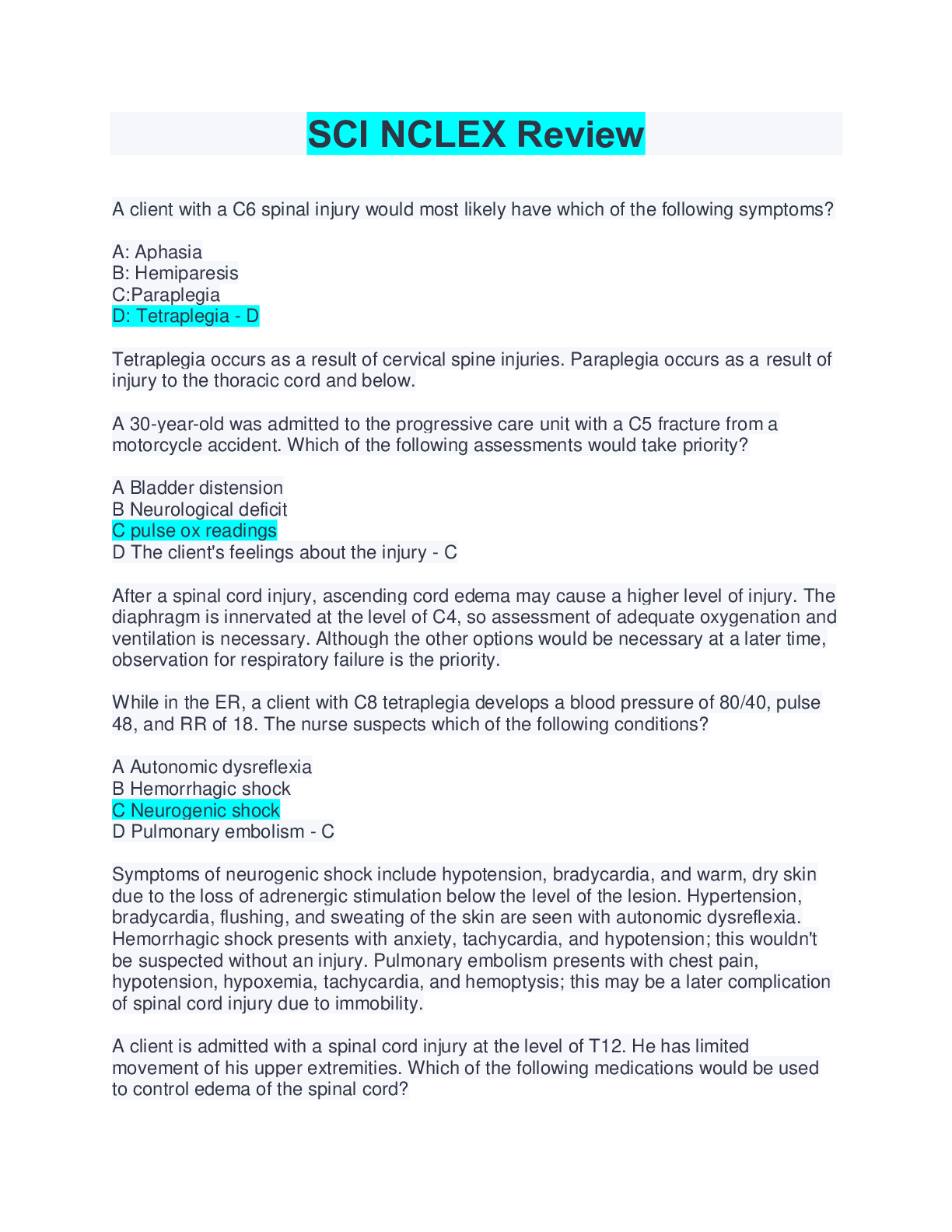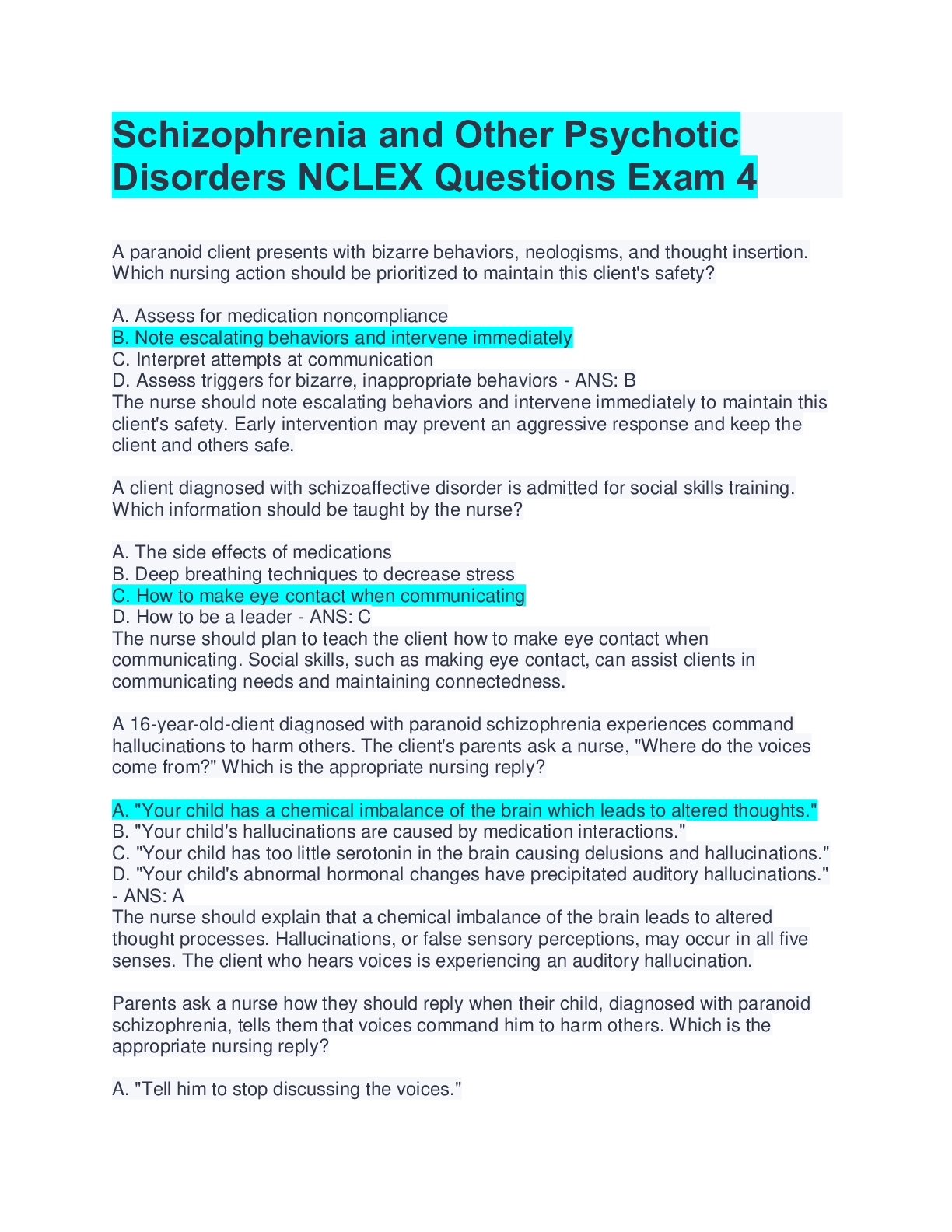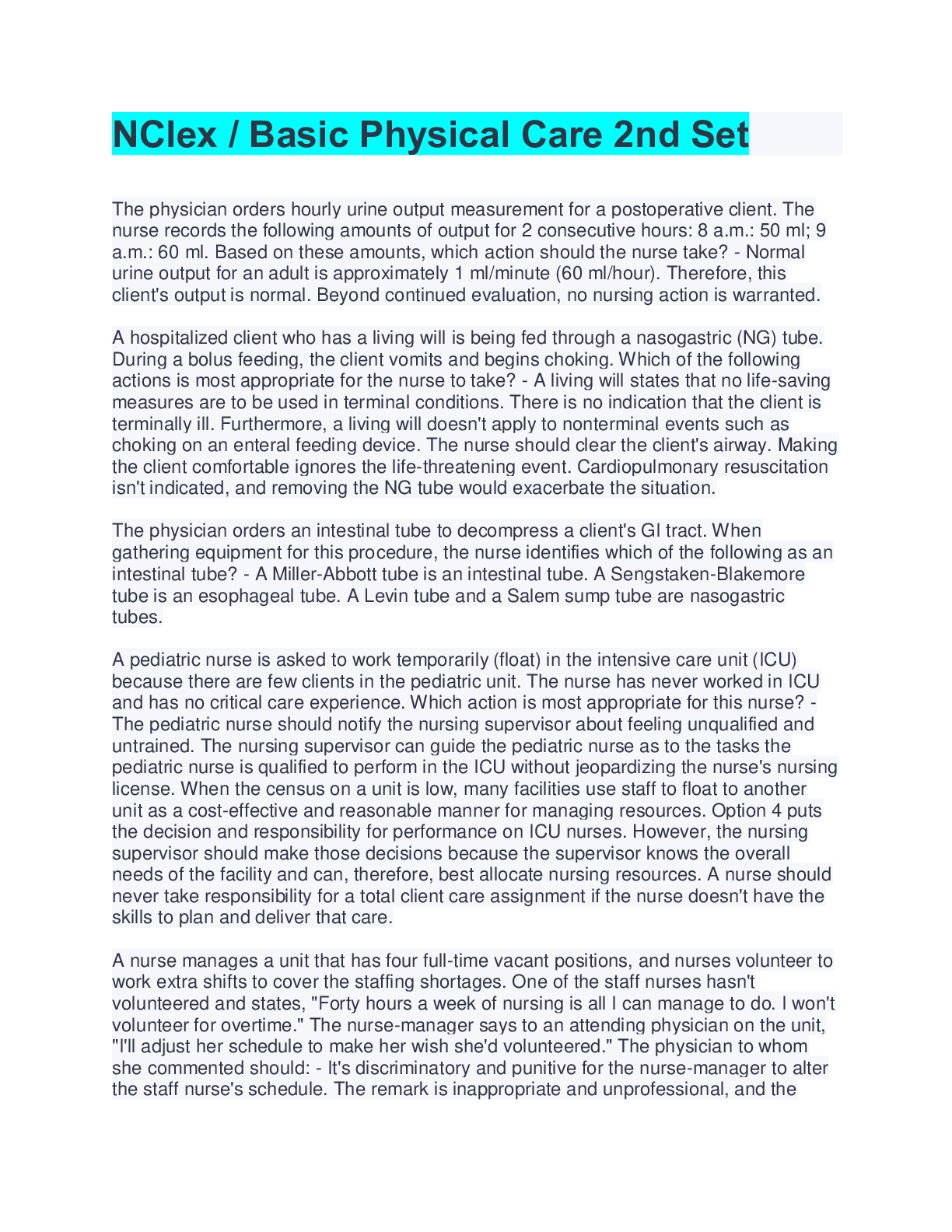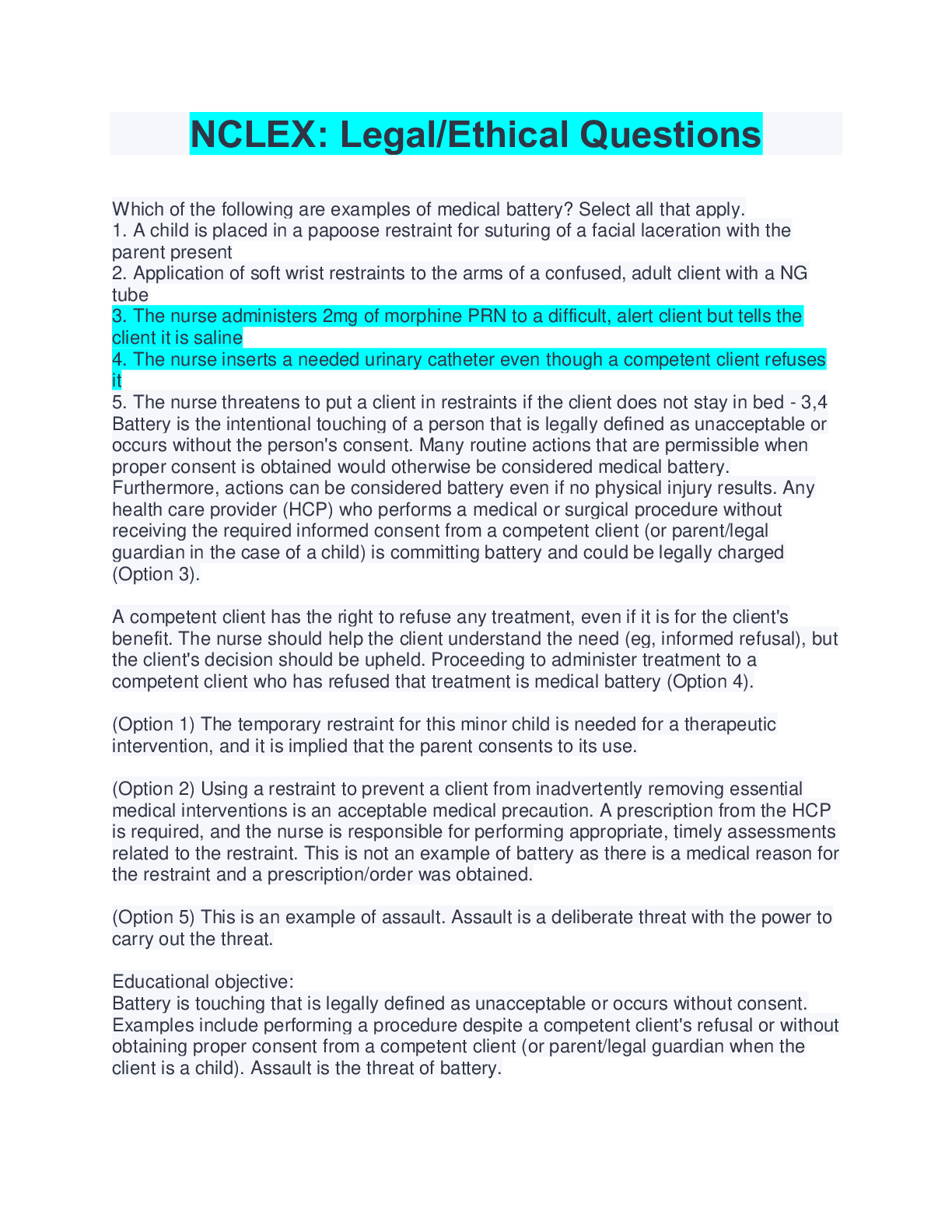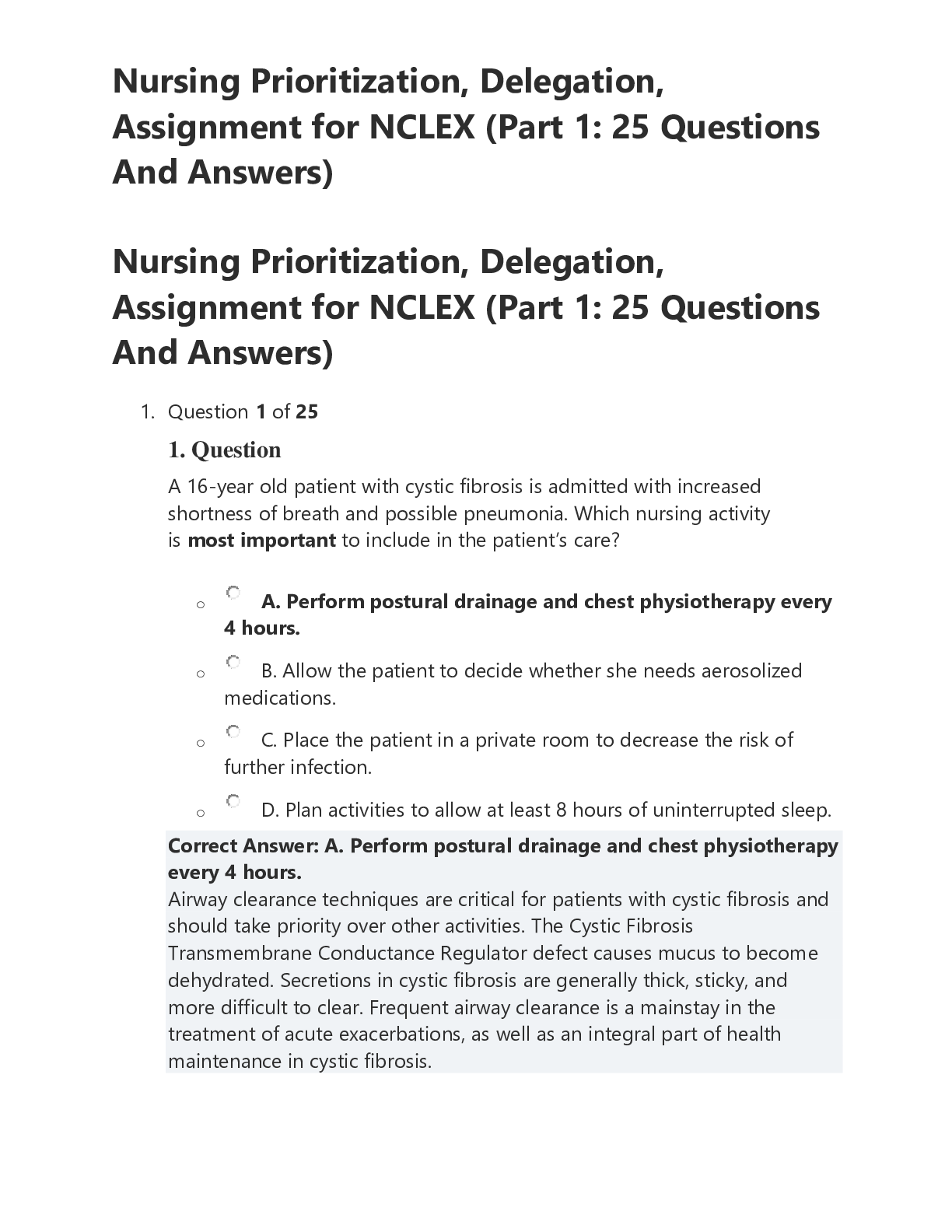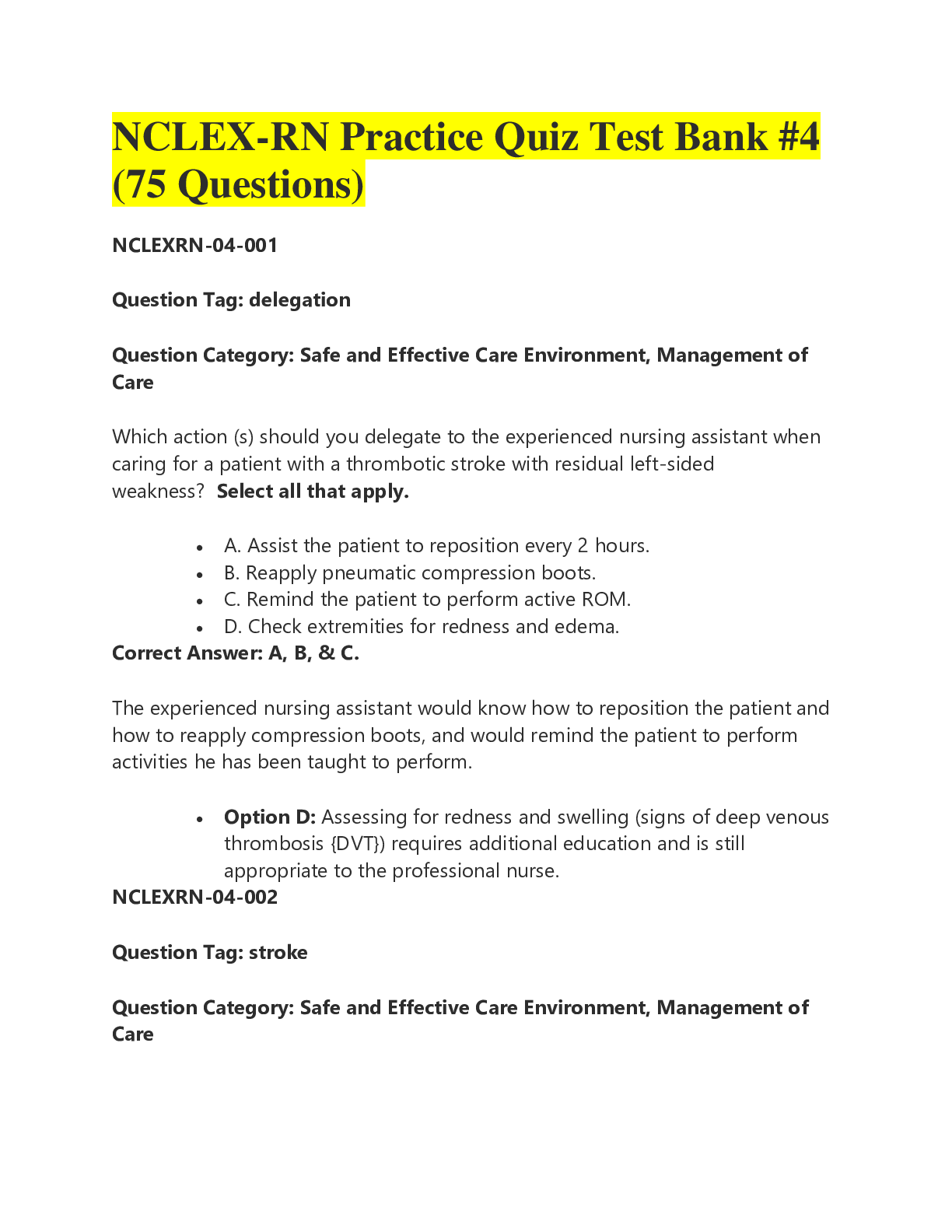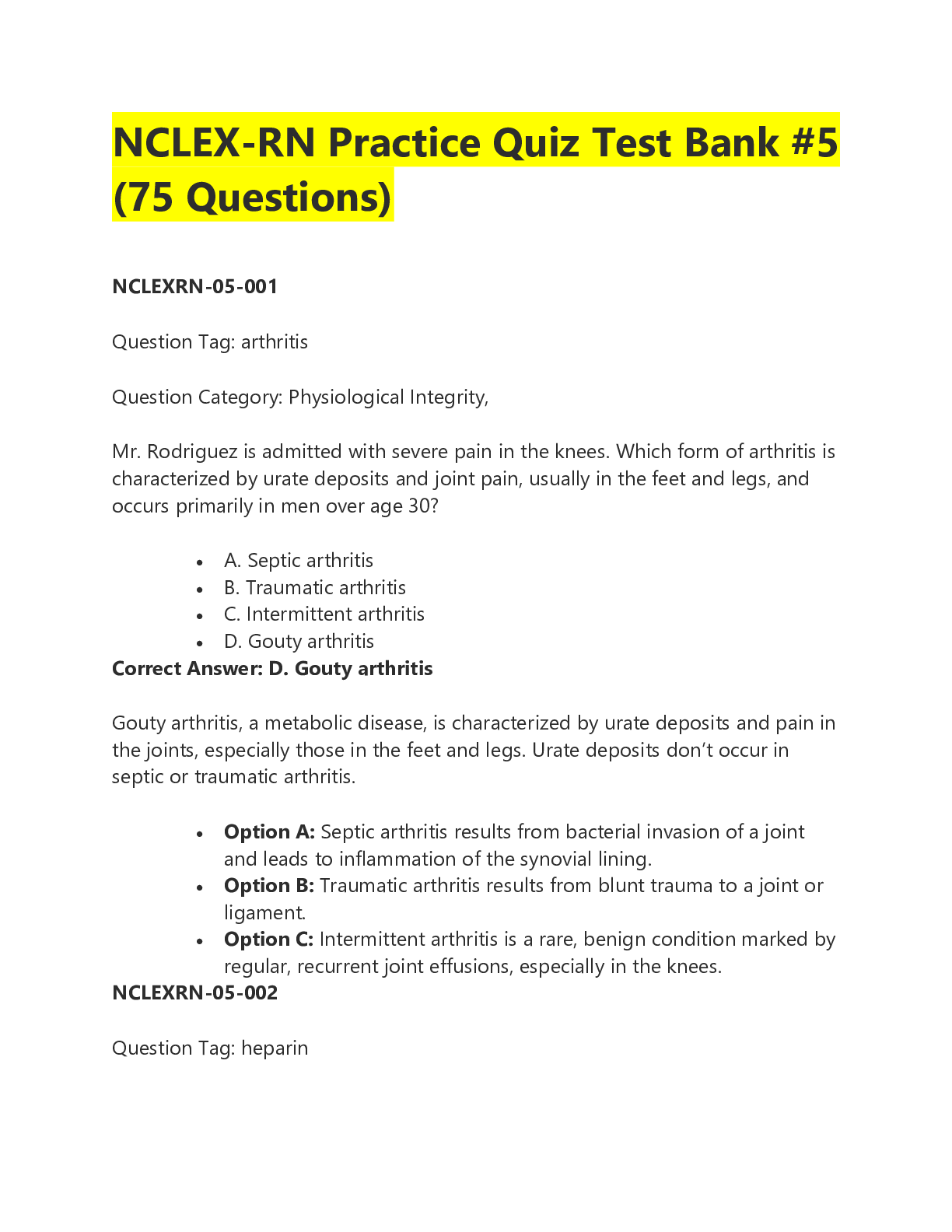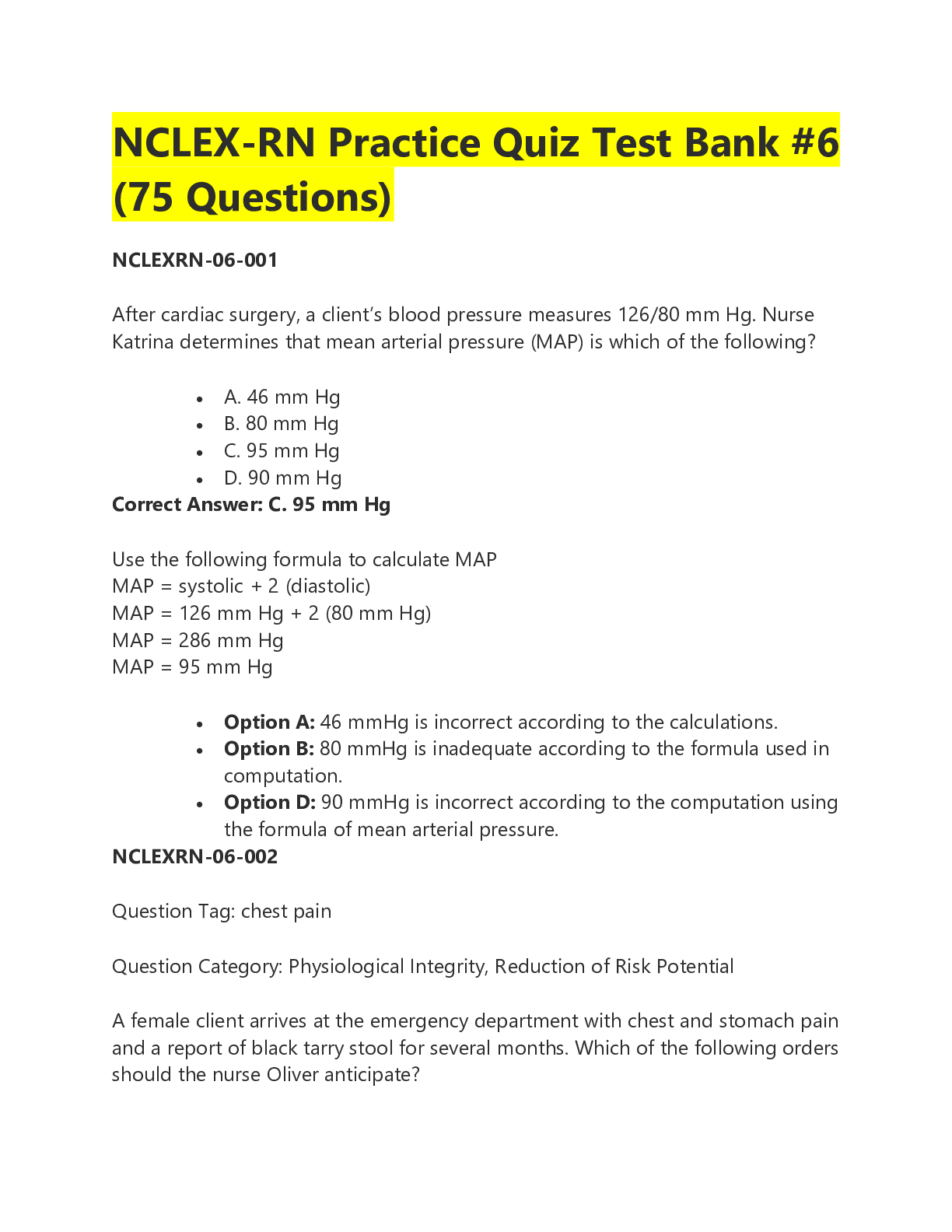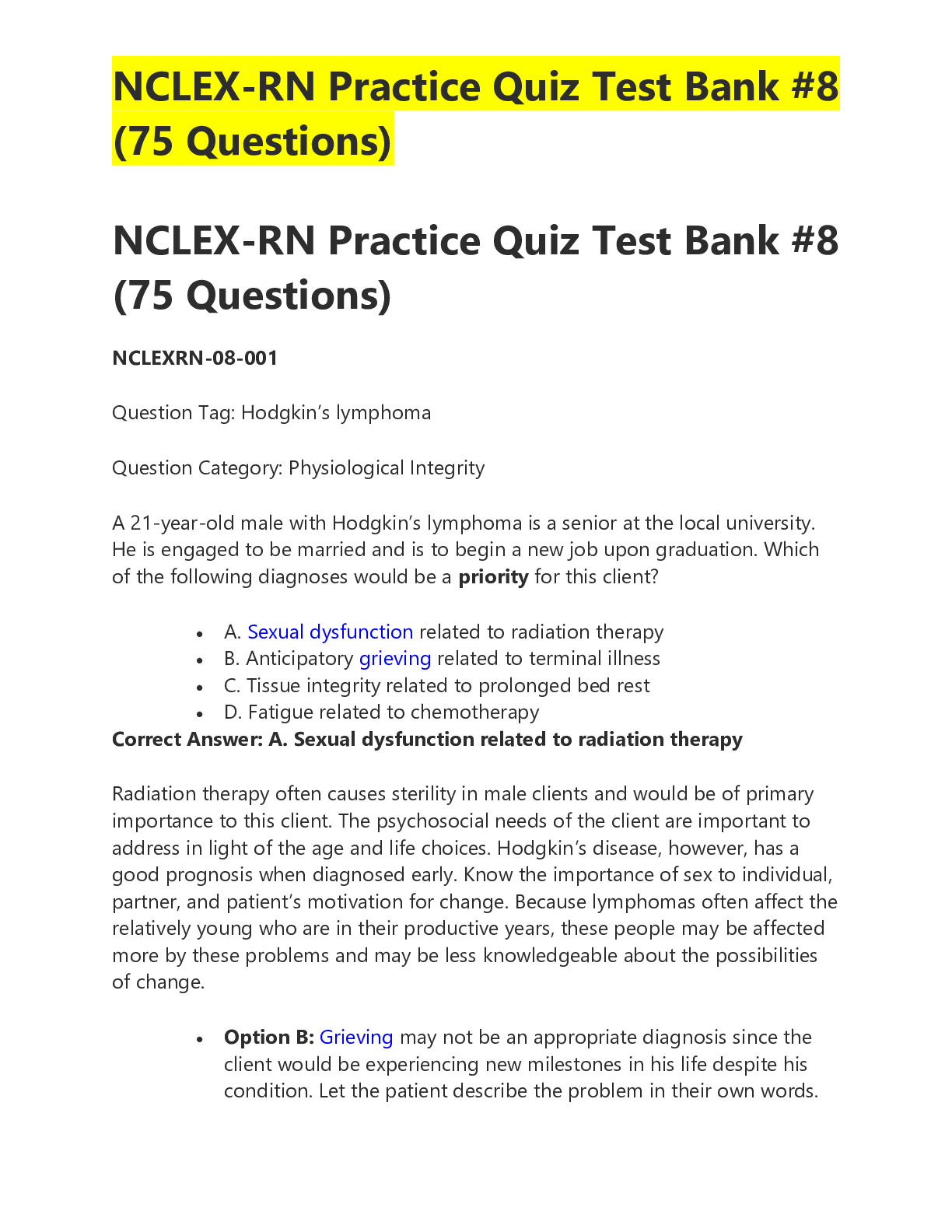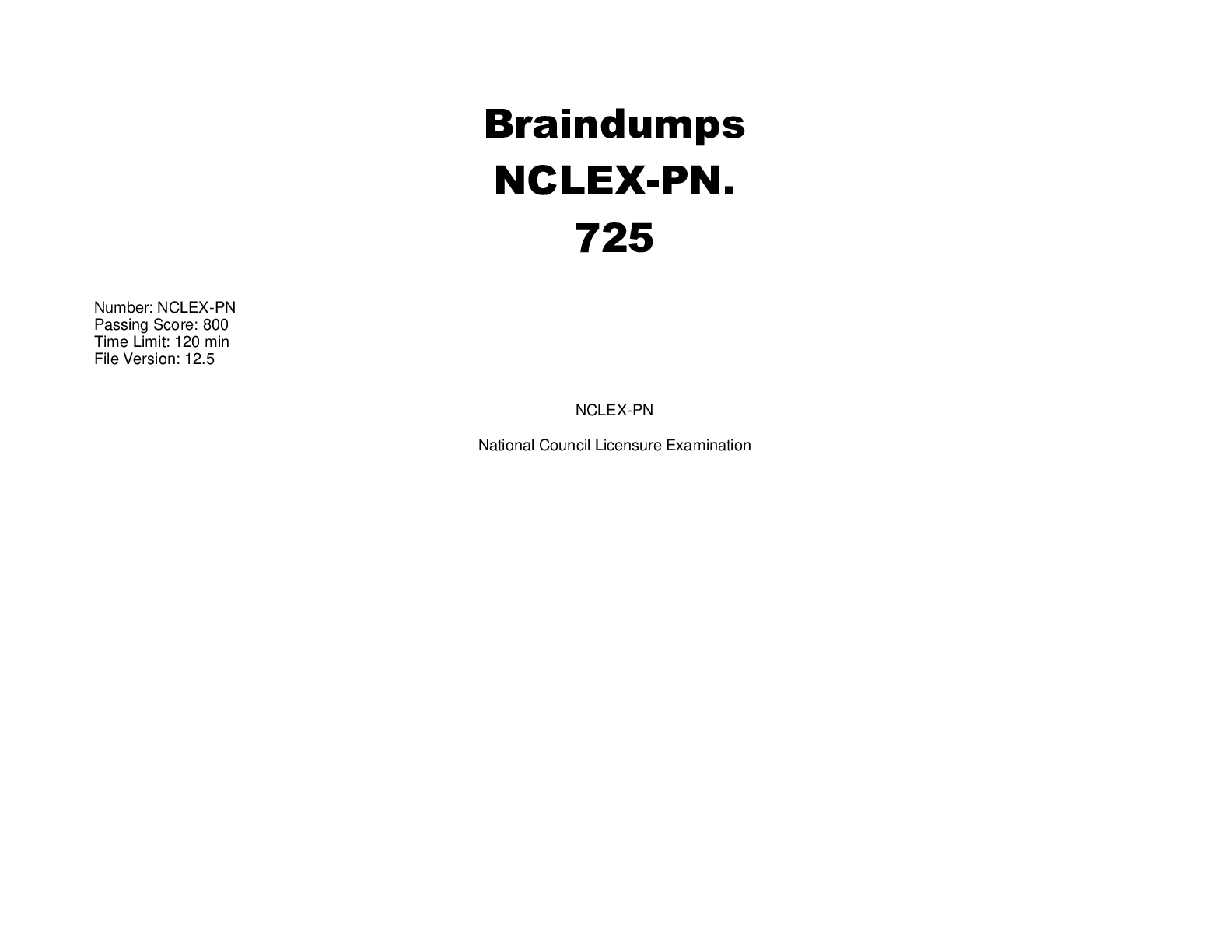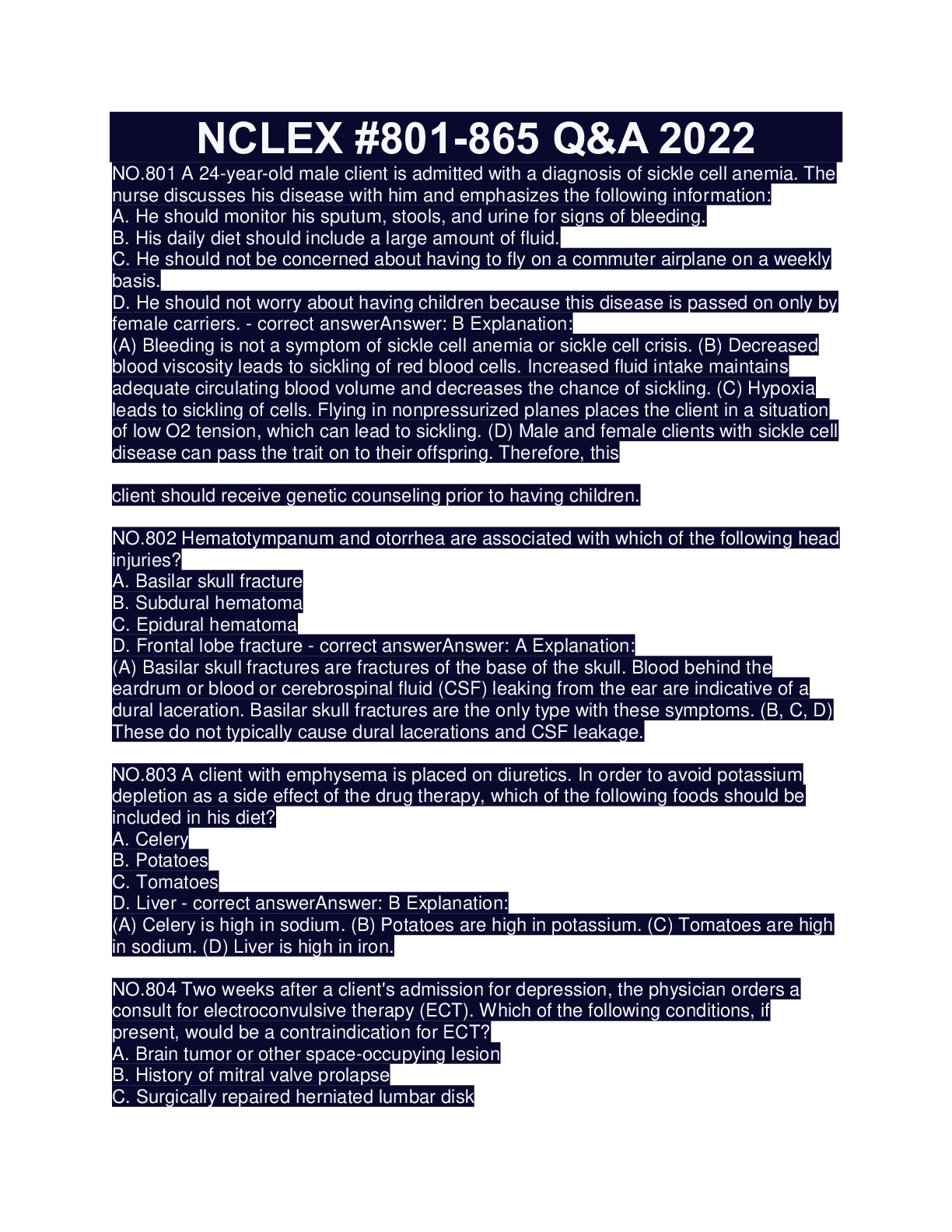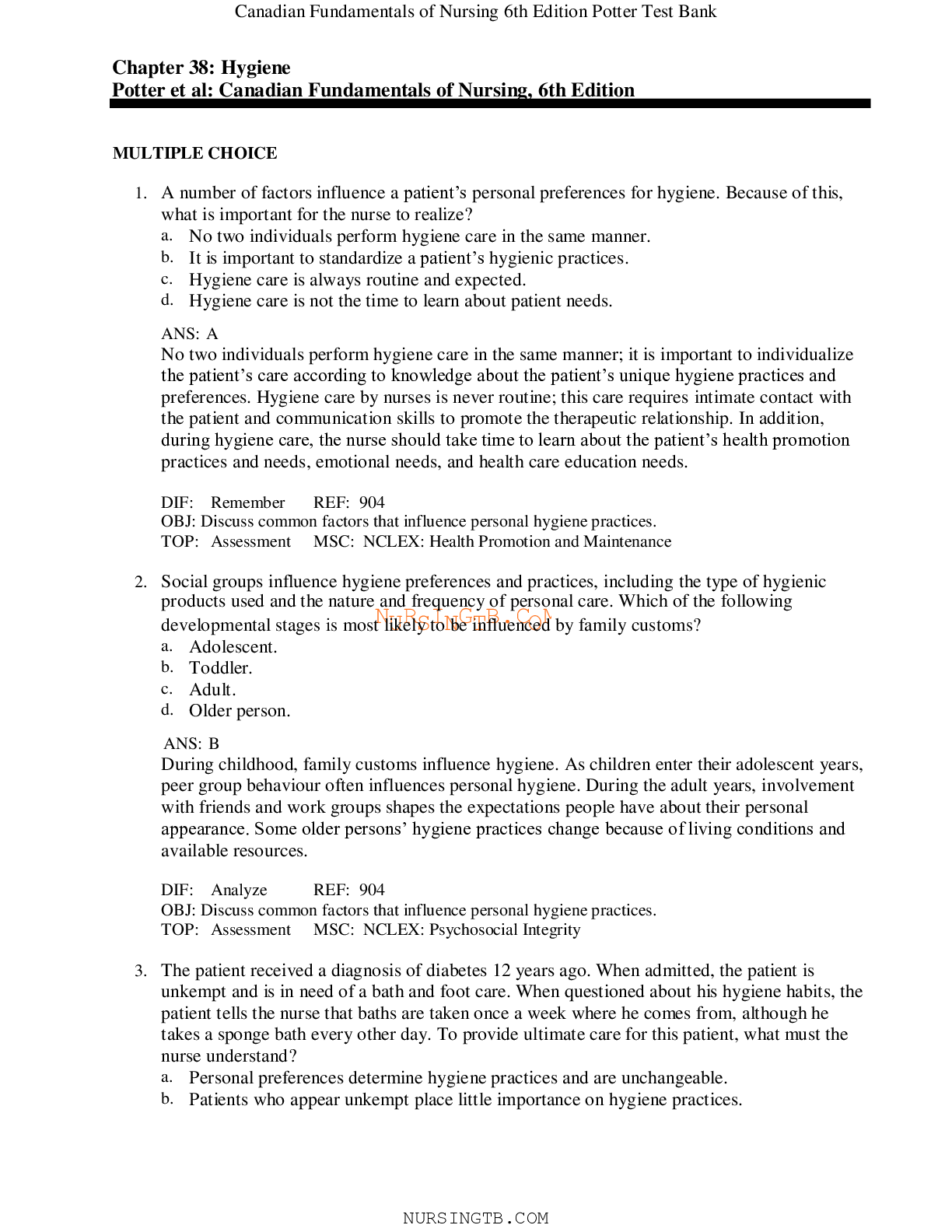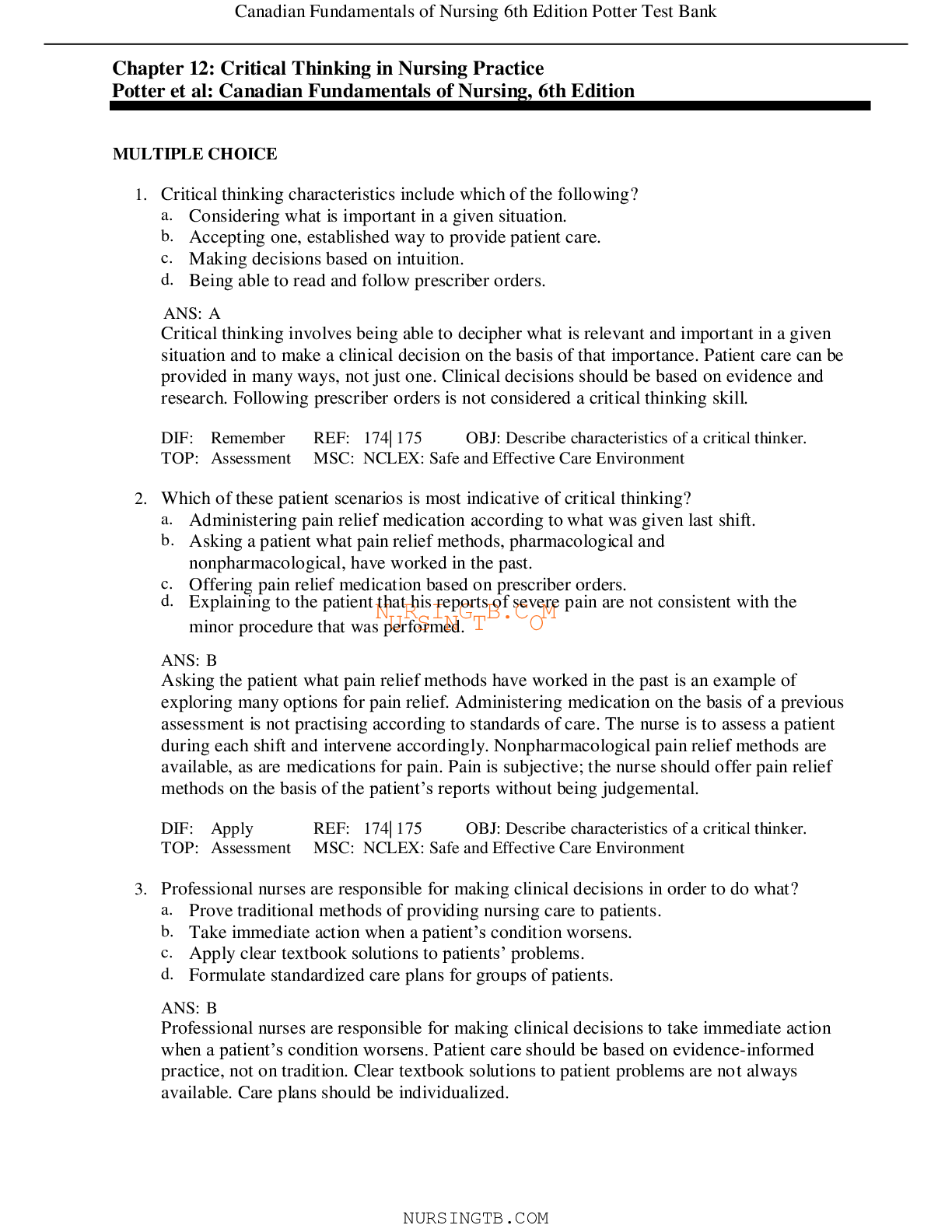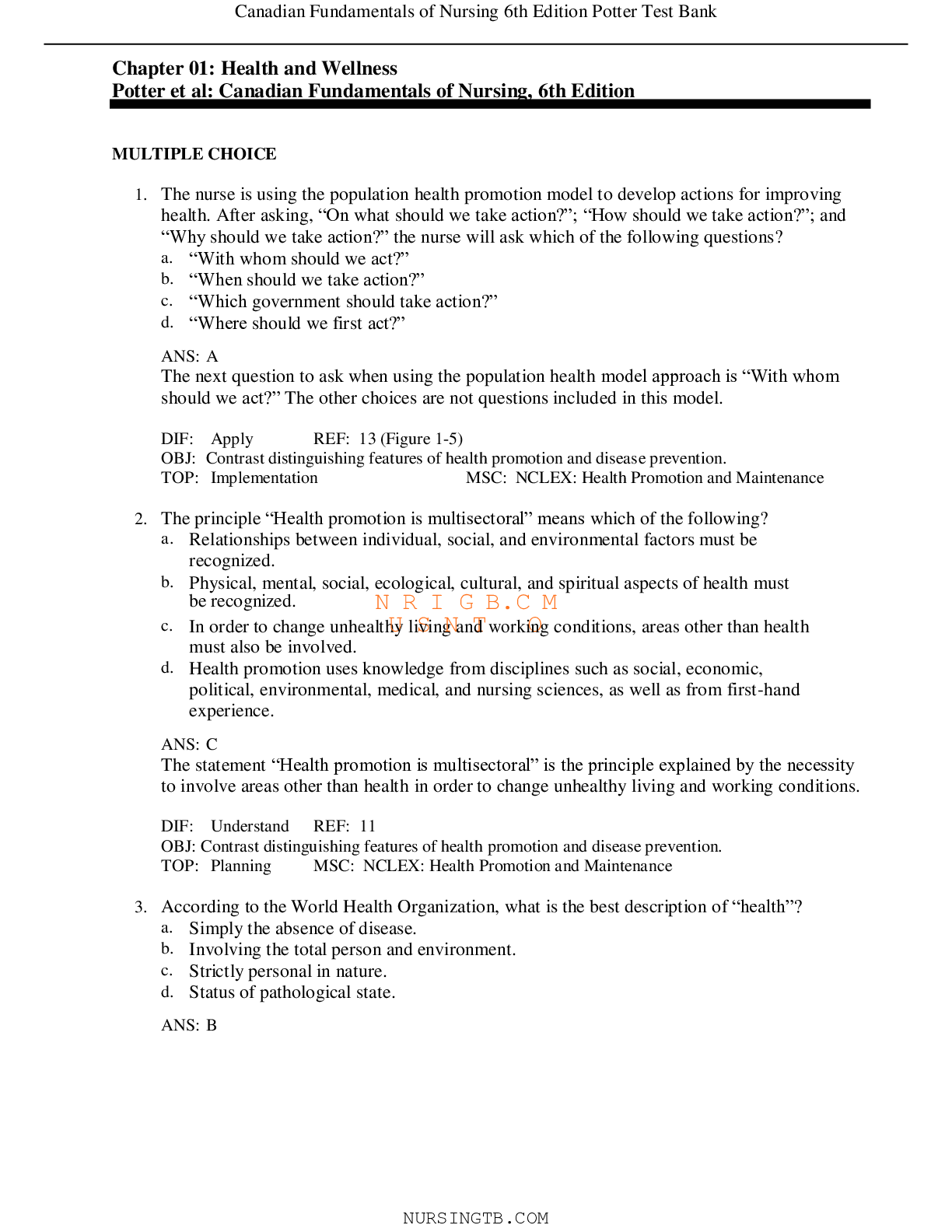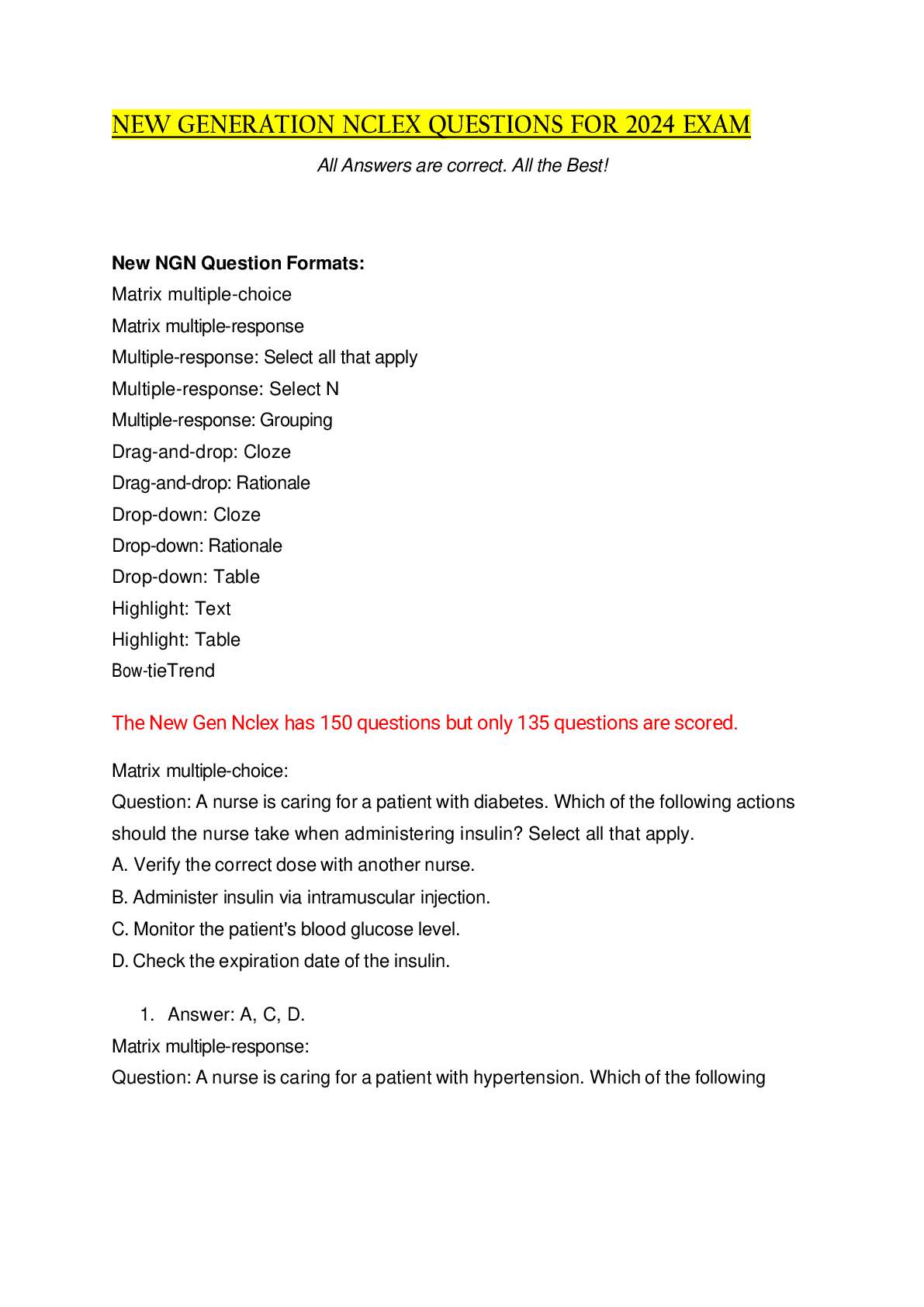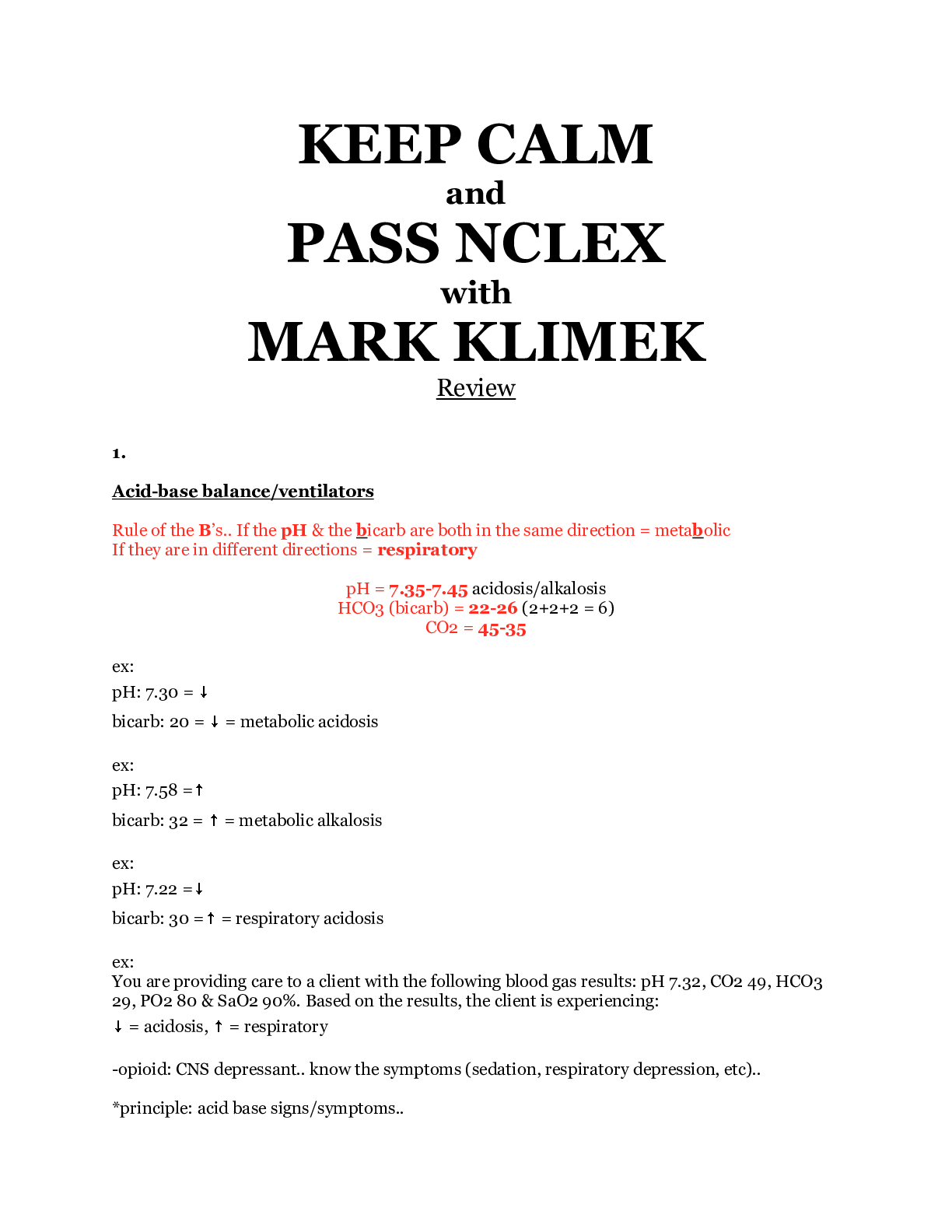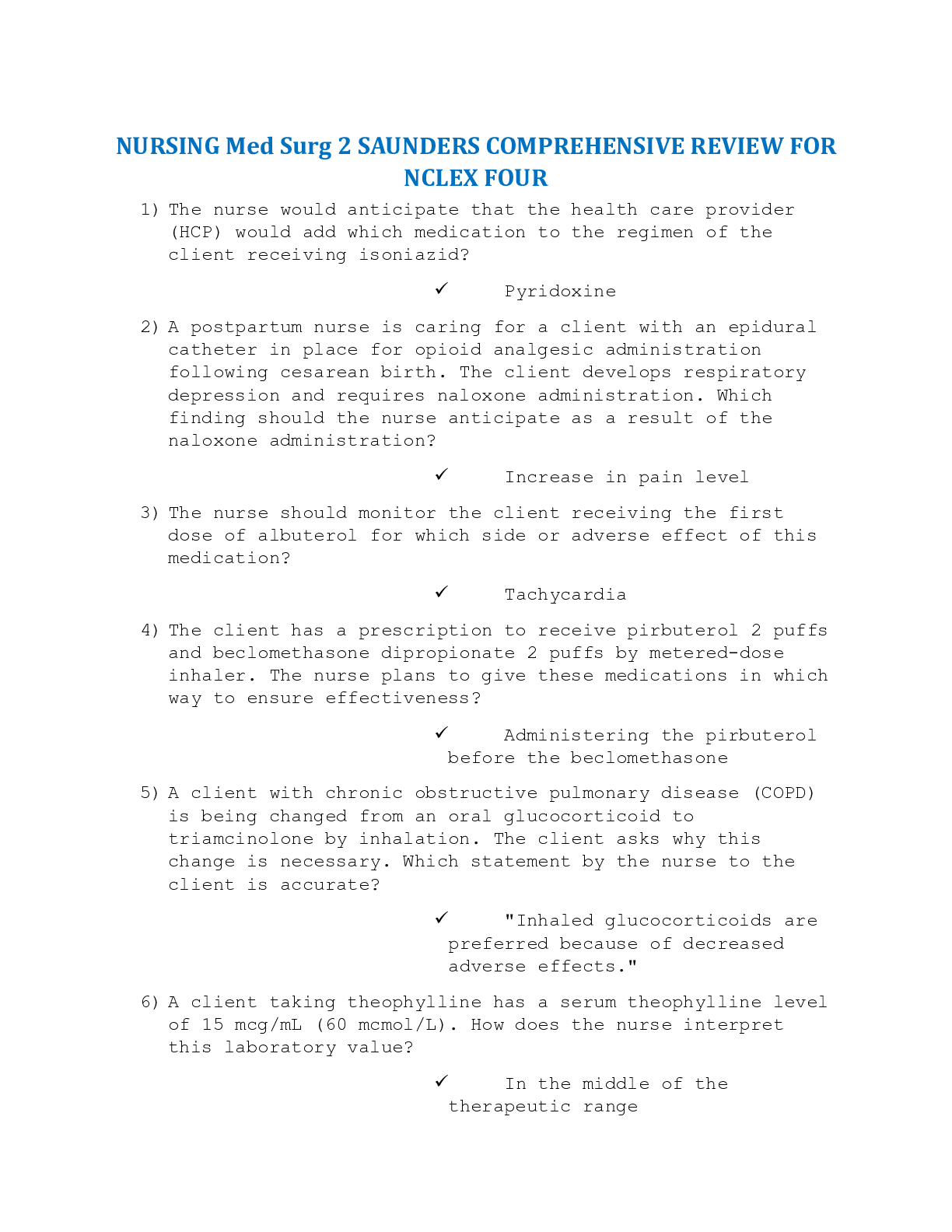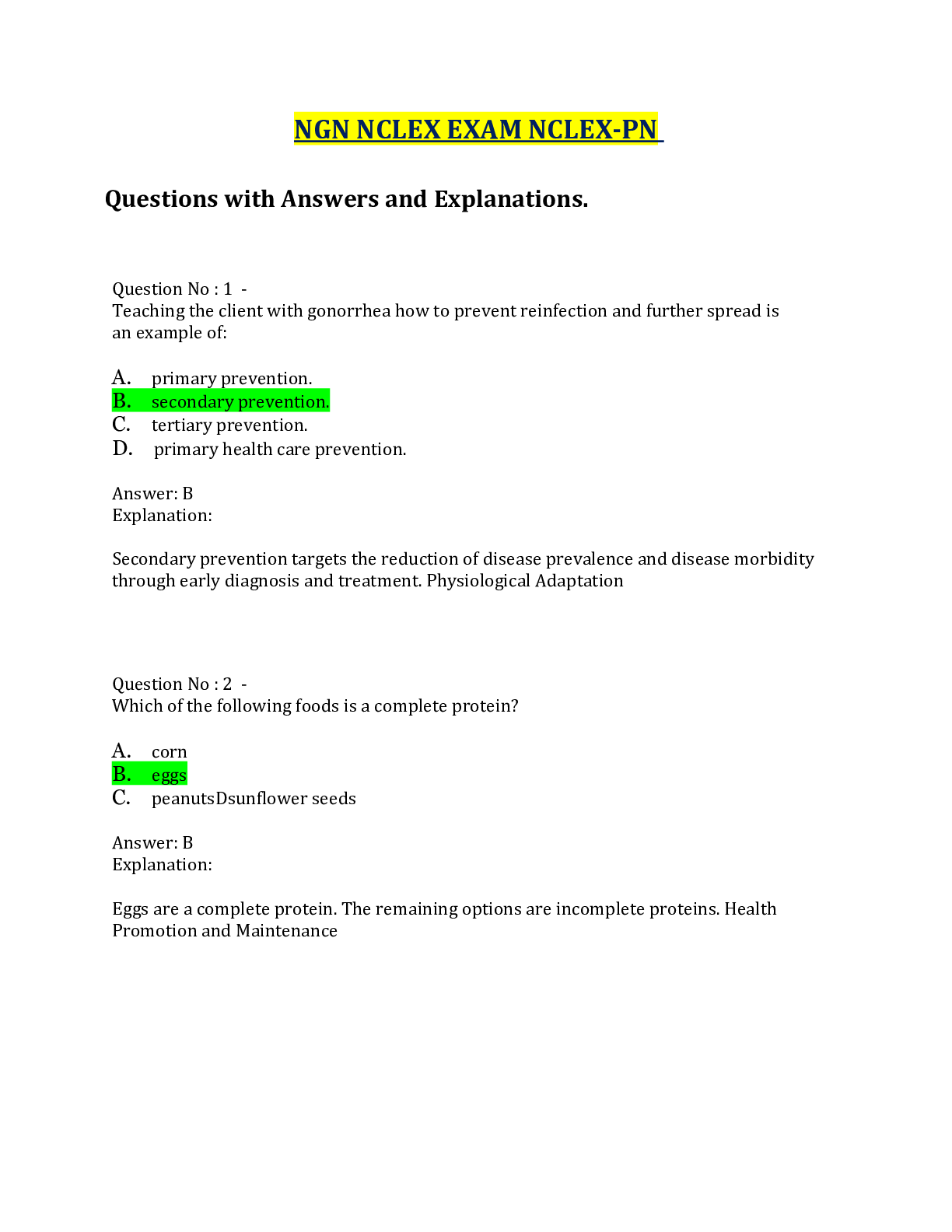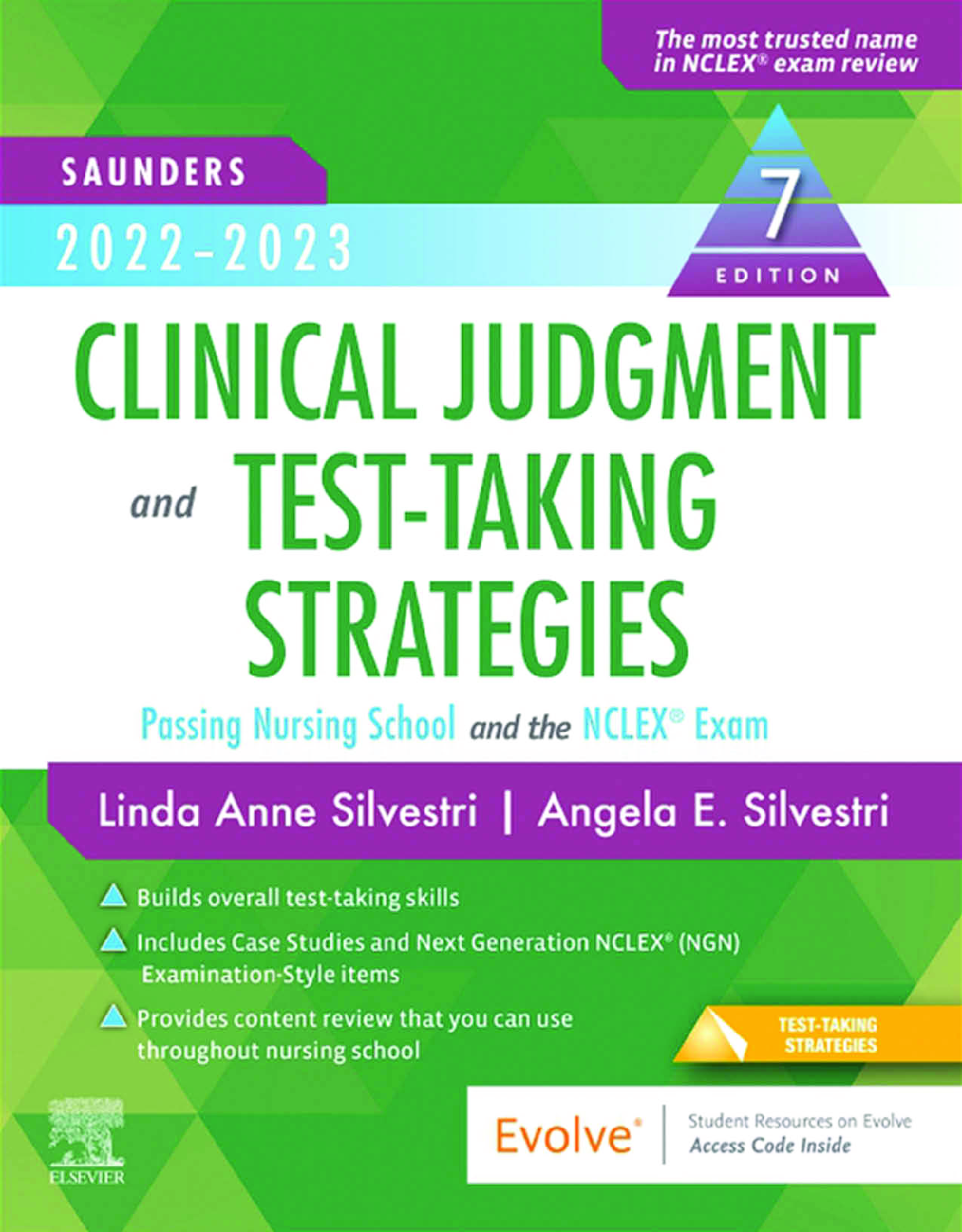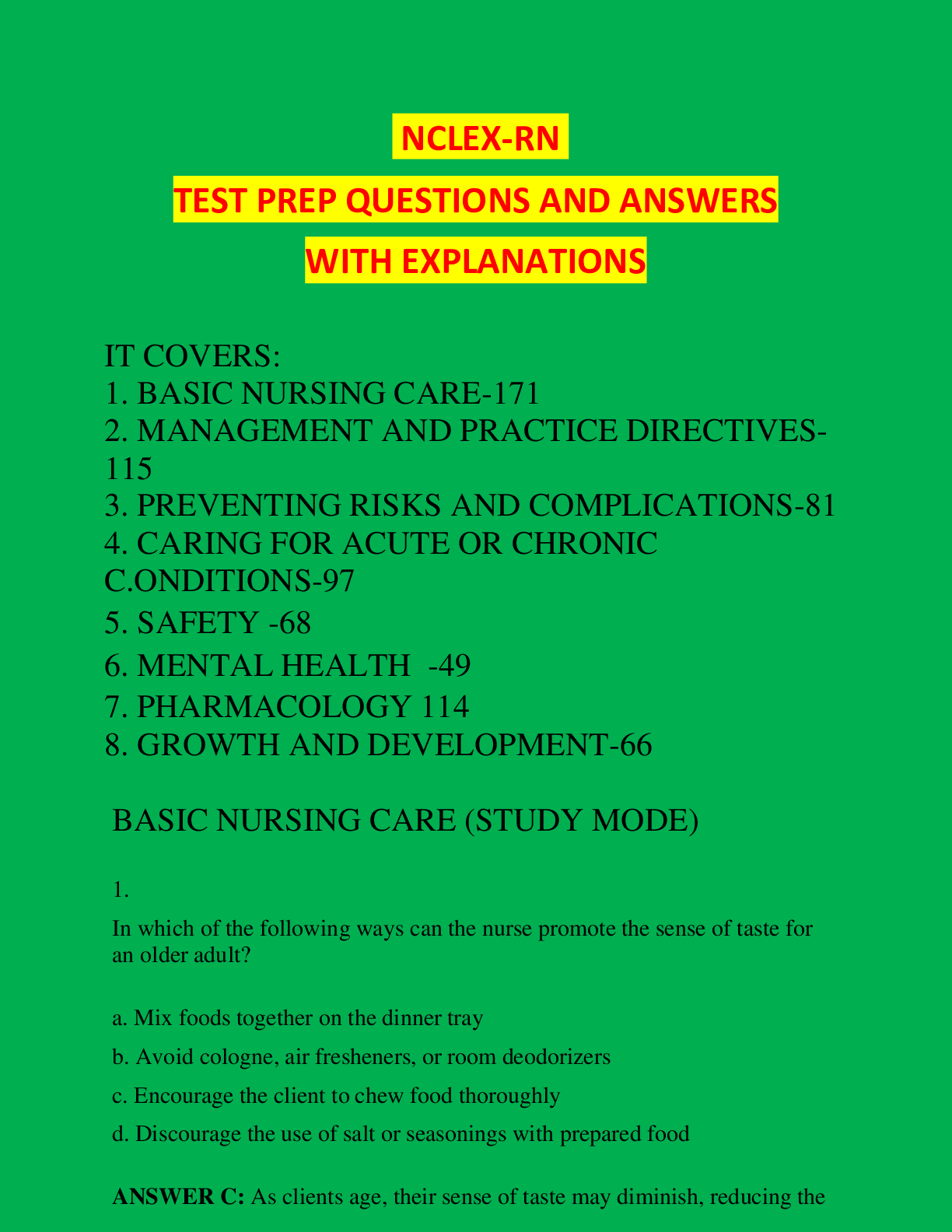*NURSING > NCLEX > Potter et al: Canadian Fundamentals of Nursing, 6th Edition/Chapter 28: Spirituality in Health and H (All)
Potter et al: Canadian Fundamentals of Nursing, 6th Edition/Chapter 28: Spirituality in Health and Health Care
Document Content and Description Below
Chapter 28: Spirituality in Health and Health Care Potter et al: Canadian Fundamentals of Nursing, 6th Edition MULTIPLE CHOICE 1. The word spirituality derives from the Latin word spiritus, ... which refers to breath or wind. Today, spirituality can be described as which of the following? 2. The nurse is caring for a patient who claims that he does not believe in God and does not believe in an “ultimate reality.” The nurse realizes what about this patient? 3. The nurse is caring for a patient who is terminally ill with very little time left to live. The patient states, “I always believed that there was life after death. Now, I’m not so sure. Do you think there is?” The nurse states, “I believe there is.” What has the nurse attempted to do? 4. In discussing spirituality with adolescent patients, of what should the nurse be aware? 5. The nurse is admitting a patient to the hospital. The patient states that he is a very spiritual person but does not practise any specific religion. What should the nurse understand about these statements? 6. Which of the following is an intervention that will facilitate connectedness? 7. Which statement about religion and spirituality is true? 8. What is the best statement by a nurse who is assessing the spiritual needs of a 76-year-old patient who was just admitted to the nursing unit with terminal cancer of the liver? Stating the observation of the patient having a Bible opens communication regarding the patient’s source of strength. Assessing a patient’s sources of strength and faith can direct interaction with him or her, including medical treatment plans. “What do you believe happens to your spirit when you die?” is not the best response, as it does not provide information that would assist the nurse in meeting the patient’s spiritual needs. “We would allow members of your church to visit you whenever you desire” is not the best response, as it implies both that the patient goes, or should go, to church and the assumption that church members are a source of strength for the patient. It does not provide assessment information to determine the patient’s spiritual needs. “Has your terminal condition made you lose your faith or beliefs?” has a negative connotation and does not help assess the patient’s sources of strength or beliefs. DIF: Understand REF: 499 OBJ: Describe a process for understanding patients' spirituality. TOP: Assessment MSC: CPNRE: Foundations of Practice 9. What is the nurse’s initial action while working with a patient to assess and support the patient’s spirituality? a. Referring the patient to the agency chaplain. b. Helping the patient to use faith to get well. c. Providing a variety of religious literature. d. Determining the patient’s perceptions and belief system. ANS: D To assess and support the patient’s spirituality, the nurse should first determine the patient’s perceptions and belief system. Exploring the patient’s spirituality may reveal responses to health problems that necessitate nursing intervention, or it may reveal the existence of a strong set of resources that enable the patient to cope effectively. Although the agency chaplain may be a source for referral, such a UrefeSrralNis nTot the fOirst action the nurse should take in assessing and supporting a patient’s spirituality. The nurse needs first to assess a patient’s spirituality to determine the patient’s perceptions and belief system before attempting to assist the patient to use faith to get well. Providing a variety of religious literature may be ineffective because it does not address the patient as an individual and does not help assess the patient’s personal spiritual needs. DIF: Apply REF: 499 OBJ: Describe a process for understanding patients' spirituality. TOP: Implementation MSC: CPNRE: Foundations of Practice 10. If a patient is identified as following the traditional health care beliefs of Judaism, while planning patient care, which of the following should be incorporated in nursing care? a. Observance of the Sabbath. b. Faith healing. c. The removal of religious symbols. d. Sacraments of Holy Communion. ANS: A Observance of the Sabbath is important to a patient who follows the traditional health care beliefs of Judaism. This patient may refuse treatments scheduled on the Sabbath. Followers of the Islamic or Christian faith may use faith healing in response to illness. Religious symbols should not be removed from individuals who practise any religion. Sacraments of Holy Communion are practised by followers of the Christian faith. DIF: Analyze REF: 502, Table 28-1 OBJ: Discuss the role of the nurse in providing spiritual nursing care. TOP: Planning MSC: CPNRE: Foundations of Practice 11. Which of the following attributes of spiritual care in nursing practice is described as a direction to place patients’ needs first and protect vulnerability? a. Altruism. b. Interpersonalism. c. Intuitiveness. d. Integrativeness. ANS: A Altruism is one attribute of spiritual care, meaning direction to place patients’ needs first and protect vulnerability. Interpersonalism is the willingness to be present and engage matters of spirituality without fear. Intuitiveness is the discernment of spiritual matters relevant to the patient. Integrativeness is an ethic of care that influences all aspects of nursing. DIF: Understand REF: 503, Figure 28-2 OBJ: Describe the relational attributes that facilitate spiritual nursing care. TOP: Planning MSC: CPNRE: Foundations of Practice 12. The patient is admitted with chronic back pain. The nurse who is caring for this patient should do which of the following? a. Focus on finding quick remedies for the back pain. b. Look at how pain influences the patient’s ability to function. c. Realize that the patient’s only goal is relief of the back pain. d. Help the patient realize thNaUt tRheSreIiNs lGitTtleBh.oCpeOoMf relief from chronic pain. ANS: B The nurse should not view the patient’s back pain as merely a problem to solve with quick remedies; rather, the nurse should examine how the pain influences the patient’s ability to function and achieve goals established in life (not just pain relief). Mobilizing the patient’s hope is central to a healing relationship. DIF: Apply REF: 497 | 504 OBJ: Describe a process for understanding patients' spirituality. TOP: Implementation MSC: CPNRE: Foundations of Practice 13. In caring for the patient’s spiritual needs, what should the nurse understand? a. Establishing presence is part of the art of nursing. b. Presence involves “doing for” the patient. c. A caring presence involves listening to the patient’s wishes only. d. The nurse must use her expertise to make decisions for the patient. ANS: A Establishing presence is part of the art of nursing. Presence involves “being with” a patient versus “doing for” a patient. The nurse should demonstrate a caring presence by listening to the patient’s concerns and willingly involving family in discussions about the patient’s health. The nurse should also show self-confidence when providing health instruction and support patients as they make decisions about their health. DIF: Understand REF: 496 | 499 OBJ: Describe the relational attributes that facilitate spiritual nursing care. TOP: Planning MSC: CPNRE: Foundations of Practice 14. When asked about his religious affiliation, a patient responds, “That’s personal; why do you want to know?” Which of the following is the most appropriate nursing response? a. “You need not answer my question if you prefer not to share that information.” b. “By knowing your religious preferences, I can best meet your spiritual needs.” c. “All information that you provide will be kept in strict confidence.” d. “I did not mean to offend you; we ask that question of all of our new admissions.” ANS: B Information about religious and spiritual beliefs and practices should be obtained from patients when they enter health care facilities. Nursing care should take into account the biological, psychological, social, cultural, and spiritual needs of patients. Applying knowledge of spiritual concepts and using therapeutic communication skills will help the nurse recognize and understand the patient’s spiritual beliefs, so “You need not answer my question if you prefer not to share that information” is not an appropriate response. Although it is true that patient information is kept confidential, it is important to understand the patient’s belief system to treat the patient with dignity and respect. In the assessment of spiritual caregiving, it is important for the nurse to inform the patient that he or she is obtaining information to ensure sensitivity to the patient’s needs and give the patient the opportunity to communicate his spiritual needs. DIF: Apply REF: 499 | 500 OBJ: Discuss the role of the nurse in providing spiritual nursing care. TOP: Implementation MSC: CPNRE: Foundations of Practice NURSINGTB.COM 15. Which of the following can be used to develop the nurse’s own spiritual awareness while facilitating the spiritual practices of others? a. Hosting a church group on the medical unit. b. Engaging in mindfulness. c. Taking part in other religions’ practices. d. Taking a university-level course on religion. ANS: B Mindfulness can be an important strategy for developing spiritual practice, both for oneself and others. Nurses should learn about various religious practices to be able to support their patients’ spiritual health, but they are not required to host a church group, take a university-level course on religion, or take part in other religions’ practices. DIF: Understand REF: 497 OBJ: Discuss the role of the nurse in providing spiritual nursing care. TOP: Implementation MSC: CPNRE: Foundations of Practice 16. The patient is having a difficult time dealing with his diagnosis of acquired immune deficiency syndrome (AIDS). He states, “It’s not fair. I’m totally isolated from my family because of this. Even my father hates me for this. He won’t even speak to me.” What does the nurse need to do? a. Assure the patient that his father will accept his situation soon. b. Use therapeutic communication to establish trust and caring. c. Point out that the patient has no control and that he has to face the consequences. d. Tell the patient, “If your father can’t get over it, forget it. You have to move on.” ANS: B The nurse needs to use therapeutic communication to establish trust and a caring presence because providing spiritual care requires caring, compassion, and respect. The nurse should not offer false hope. The nurse should help the patient maintain feelings of control. The nurse should encourage renewing relationships if possible and establishing connections with self, significant others, and a higher being. DIF: Apply REF: 500 | 501 OBJ: Describe the relational attributes that facilitate spiritual nursing care. TOP: Implementation MSC: CPNRE: Foundations of Practice 17. The nurse is caring for a patient who is in the final stages of a terminal disease. The patient is very weak but refuses to use a bedpan and wants to get up to use the bedside commode. What should the nurse do? a. Explain to the patient that he is too weak and needs to use the bedpan. b. Insert a rectal tube so that the patient no longer needs to actively defecate. c. Enlist assistance from family members if possible and assist the patient to get up. d. Put the patient on a bedpan and stay with him until he is finished. ANS: C Establishing presence is part of the art of nursing. Presence involves “being with” a patient versus “doing for” a patient. The nurse should demonstrate a caring presence by listening to the patient’s concerns and willingly involving family in discussions about the patient’s health. The nurse should support patients as they make decisions about their health. If at all possible, the nurse should encourage thNe pRatieInt toGmaBin.taCin aMs much independence as possible. Inserting a rectal tube involves “doing for” instead of “being with.” Placing the patient on the bedpan is against the patient’s wishes and is another form of “doing for.” DIF: Apply REF: 496 | 499 OBJ: Describe the relational attributes that facilitate spiritual nursing care. TOP: Implementation MSC: CPNRE: Foundations of Practice 18. In assessing the spiritual health of her patients, what should the nurse understand? a. Spiritual beliefs change as patients grow and develop. b. Spiritual health in older persons does not lead to peace and acceptance of others. c. Older persons often express spirituality by focusing on themselves. d. The basis of beliefs among older people is focused on one or two factors. ANS: A Spiritual beliefs change as patients grow and develop. Health spirituality in older persons leads to peace and acceptance of self. However, older persons often express their spirituality by turning to important relationships and giving of themselves to others. Beliefs among older people vary on the basis of many factors, such as gender, past experience, religion, economic status, and ethnic background. DIF: Understand REF: 496 OBJ: Discuss appropriate ways to facilitate patients' spiritual practices. TOP: Assessment MSC: CPNRE: Foundations of Practice 19. Which of the following are included in the five Cs of relational practice? a. Compassion, curiosity, commitment, competence, and corresponding. b. Compassion, communication, curiosity, candour, and corresponding. c. Commitment, caring, candour, communication, and competence. d. Commitment, communication, curiosity, caring, and competence. ANS: A The five Cs of relational practice are compassion, curiosity, commitment, competence and corresponding. Communication, caring, and candour are not included in this framework. DIF: Understand REF: 503, Box 28-7 OBJ: Discuss the role of the nurse in providing spiritual nursing care. TOP: Planning MSC: CPNRE: Foundations of Practice NURSINGTB.COM [Show More]
Last updated: 1 year ago
Preview 1 out of 8 pages
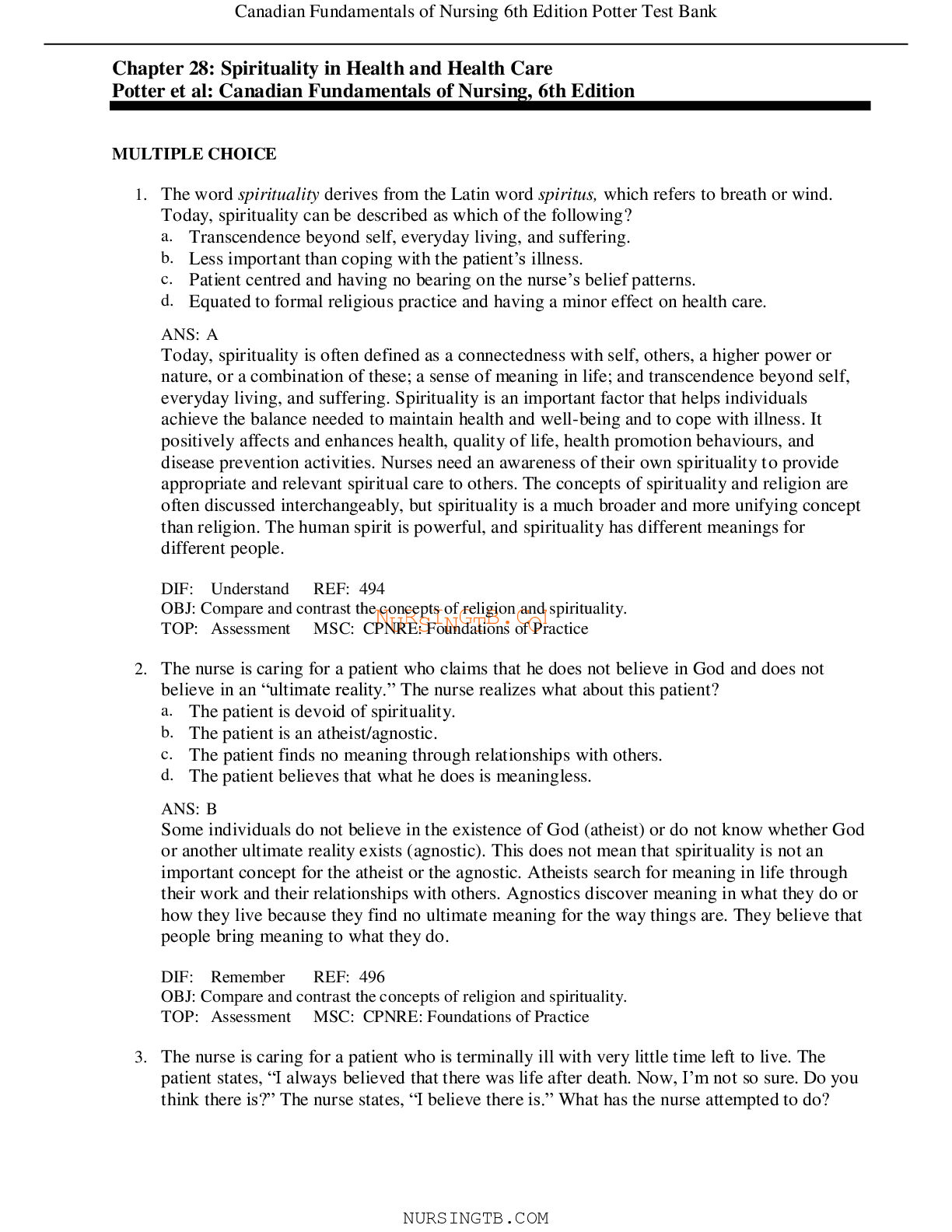
Reviews( 0 )
Document information
Connected school, study & course
About the document
Uploaded On
Aug 08, 2021
Number of pages
8
Written in
Additional information
This document has been written for:
Uploaded
Aug 08, 2021
Downloads
0
Views
50


